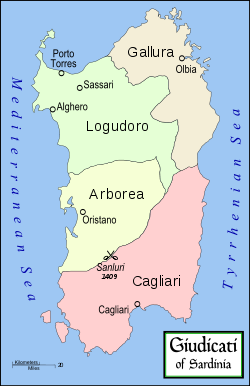- Giudicati
-
The giudicati (singular giudicato) were the indigenous kingdoms of Sardinia from about 900 until 1410, when the last fell to the Aragonese. The rulers of the giudicati were giudici (singular giudice), from the Latin iudice (pl. iudices), often translates as "judge". The Latin for giudicato (judgeship) was iudicatus (pl. iudicati), sometimes spelled with a "j", as in judicatus. The Latin terms were corrupted over time into judike/judikes (iudike/iudikes).
The title of iudex was that of a Byzantine governor (praeses or judex provinciae) dating from the creation of the Exarchate of Africa in 582. The Byzantines were totally cut off from the Tyrrhenian Sea by the Muslim conquest of Sicily in 827. A letter of Pope Nicholas I in 864 mentions for the first time the "Sardinian judges," and their autonomy was clear in a later letter of Pope John VIII in which he referred to them as principes ("princes"). The local authority was exercised initially by curatores — who each ruled over a curatoria — who were subject to the judges, whose responsibilities included the administration of justice and command of the army.
Originally the giudicati were Byzantine districts that became independent due to the Arab expansion in the Mediterranean, that obstructed connenctions between Sardinia and Byzantium. The governors were initially elected by the Corona de Logu (parliament) but, as elsewhere in medieval Europe, hereditary dynasties were soon established. The known medieval giudicati were:
- Giudicato of Agugliastra (also known as Ogliastra; short-lived, annexed by Cagliari)
- Giudicato of Arborea (with capital in Oristano), 13 or 14 curatoriae
- Giudicato of Cagliari (also known as Cagliaritano or Pluminos), 14 curatoriae
- Giudicato of Gallura, 10 curatoriae
- Giudicato of Logudoro (also known as Torres), 20 curatoriae
In the early thirteenth century, three of the giudicati successively passed to women by inheritance: Gallura to Elena in 1203, Cagliari to Benedetta in 1214, and Logudoro to Adelasia in 1232. By the end of the century, three giudicati had fallen to either the Republic of Pisa or Genoa: Cagliari in 1258 to Pisa, Logudoro in 1259 to powerful Genoese families of merchants (most notably the Dorias), and Gallura in 1288 to Pisa, although the latter was disputed until the early fourteenth century. In the fourteenth century the territories conquered by Pisa were seized by the Crown of Aragon. The Genoese who had taken possession of parts of Sardinia also clashed with the Aragonese expansion.
The giudicato of Arborea survived much longer compared to the other giudicati and greatly expanded its territory in the fourteenth century, reaching its peak under Marianus IV the Great and Eleanor, its heroine. The expansion of Arborea led to clashes with Aragon, which desired the mineral resources of the island and command of the sea routes of the western Mediterranean. The war between Arborea and Aragon was fought on and off for more than 100 years. During this time the rulers of Arborea developed the ambition to unite all of Sardinia under their rule and create an independent Sardinian state. This ambition is given voice in the frequent references to the Republica Sardisca ("Sardinian Republic") in official Arborean documents (notably the Carta de Logu).
Arborea lost the war against Aragon through defeat in the Battle of Sanluri in 1409 and the loss of the capital Oristano in 1410. After some years during which Arborean rulers failed to organise a successful resurgence, they sold the giudicato to the Crown of Aragon in 1420.
See also
Sources
- Moore, John C. "Pope Innocent III, Sardinia, and the Papal State." Speculum, Vol. 62, No. 1. (Jan., 1987), pp 81–101.
- Ghisalberti, Alberto M. (ed). Dizionario Biografico degli Italiani: I Aaron – Albertucci. Rome, 1960.
- Ghisalberti, Alberto M. (ed). Dizionario Biografico degli Italiani: VI Baratteri – Bartolozzi. Rome, 1964.
- Ghisalberti, Alberto M. Dizionario Biografico degli Italiani: VIII Bellucci – Beregan. Rome, 1966.
- Ghisalberti, Alberto M. (ed). Dizionario Biografico degli Italiani: XXVII Collenuccio – Confortini. Rome, 1982.
- Caravale, Mario (ed). Dizionario Biografico degli Italiani: Guglielmo Gonzaga – Jacobini. Rome, 2000.
- Solmi, A. Studi storici sulle istituzioni della Sardegna nel Medioevo. Cagliari, 1917.
- Solmi, A. "Un nuovo documento per la storia di Guglielmo di Cagliari e l'Arborea." Archivio storico sardi. VI. (1908), pp 193–212.
- Loddo Canepa, F. "Note sulle condizioni economiche e giuridiche degli abitanti di Cagliari dal secolo XI al XIX." Studi sardi. X–XI, 1952, pp 237ff.
- Nowé, Laura Sannia. Dai "lumi" dalla patria Italiana: Cultura letteraria sarda. Mucchi Editore: Modena, 1996.
- Oliva, A. M. "Guglielmo di Massa. «Al pro marques de Sardenha, qu'ab joi viu et ab sen renha»." Gli Obertenghi di Massa e della Lunigiana ed i Regno della Sardegna, secoli 12.–14. pp 85–108. M. G. Armanini et al.: Pisa, 1999.
- Petrucci, S. Re in Sardegna, a Pisa cittadini. Bologna, 1988.
- Baudi di Vesme, Benedetto. "Guglielmo di Cagliari e l'Arborea." Archivio storico sardo. I. (1905), pp 12–51, 173–209.
- Scano, D. "Serie cronol. dei giudici sardi." Arch. stor. sardo. 1939.
- Besta, E. and Somi, A. I condaghi di San Nicolas di Trullas e di Santa Maria di Bonarcado. Milan, 1937.
Categories:- History of Sardinia
- Medieval Italy
- Byzantine governors
- Former countries on the Italian Peninsula
- 10th-century establishments
Wikimedia Foundation. 2010.

